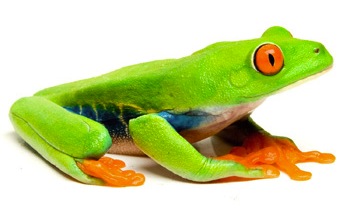Red-Eyed Tree Frog: The Scary Iconic Amphibian

The best defense of an unarmed creature is to intimidate with their eyes. This is precisely what Agalychnis callidryas does with its fearful, bulging, big red eyes, thus nicknamed Red-Eyed tree frog. These teacup-sized amphibians, though brightly coloured, are not poisonous and dwell in the tropical rainforests of Central America and northern South America. They have become the symbol for the movement to protect the rainforests due to their popularity.
Here are some details about this iconic tree frog.
The Red and Green Fact
Dark brown in color when young, they become green on maturation, with yellow and blue stripes on their sides and orange toes. When startled, they instantly expose their brightly colored parts, confusing the predator and making them pause, which gives the opportunity to the Red-Eyed tree frog to run away.
Dark brown in color when young, they become green on maturation, with yellow and blue stripes on their sides and orange toes. When startled, they instantly expose their brightly colored parts, confusing the predator and making them pause, which gives the opportunity to the Red-Eyed tree frog to run away.
Not only do they flash their eyes and skin, they slightly change the color of their skin, camouflaging themselves.
Their huge sensitive eyes have a third eyelid called nictitating membrane for extra protection, adhesive pads on the toes, soft skin on the ventral side, though rough and thick, but sensitive skin on its back.
The tree frogs grow to maximum length of three inches, and mostly live on trees near water pools, making great jumps, for which they are sometimes called ‘monkey frogs.’ They are nocturnal creatures; they rest all day under big leaves hiding their bright parts, tucking the orange feet under their belly, and keep their big red eyes shut. This way they appear fully green, smartly blending with the surroundings. Being carnivorous by nature, the Red-Eyed tree frog eats flies, moths, crickets, and other insects, as well as small invertebrates, even small frogs.
At the time of mating in the rainy season, the female who is slightly larger than the male, carries the male on its back for several hours, then chooses a leaf above the water to lay the eggs, which later develop into tadpoles and fall in the water below to metamorphose into frogs in several months. They mature into adults in about 2 years and live up to 10 years in captivity. If in captivity, the vivarium should have live tropical plants and be monitored under controlled conditions. This includes retaining high humidity, with night and day temperatures varying from 22 degrees Celsius to 28 degrees Celsius, created by an artificial light having 12-hour automated on and off cycle. Extensive human developments are encroaching on the precious rain forest lands, threatening the existence of the Red-Eyed tree frog and endangering the ecosystem.


